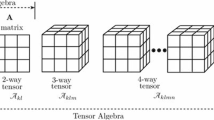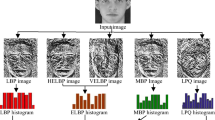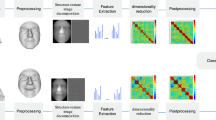Abstract
In this paper, a frequency domain feature extraction algorithm for palm-print recognition is proposed, which efficiently exploits the local spatial variations in a palm-print image. The entire image is segmented into several small spatial modules and the effect of modularization in terms of the entropy content of the palm-print images has been investigated. A palm-print recognition scheme is developed based on extracting dominant spectral features from each of these local modules using a two-dimensional discrete cosine transform (2D-DCT). The proposed dominant spectral feature selection algorithm offers the advantage of having very low feature dimension, and it is capable of capturing precisely the variations in detail within the palm-print image. It is shown that because of modularization of the palm-print image, the discriminating capabilities of the proposed features are enhanced, which results in a very high within-class compactness and between-class separability of the extracted features. A principal component analysis is performed to further reduce the feature dimension. From our extensive experimentations on different palm-print databases, it is found that the performance of the proposed method in terms of recognition accuracy and computational complexity is superior to that of some of the recent methods.






























Similar content being viewed by others
References
C.I. Chang, Multiparameter receiver operating characteristic analysis for signal detection and classification. IEEE Sens. J. 10(3), 423–442 (2010)
T. Connie, A. Jin, M. Ong, D. Ling, An automated palmprint recognition system. Image Vis. Comput. 23, 501–515 (2005)
M.P. Dale, M.A. Joshi, N. Gilda, Texture based palmprint identification using DCT features, in Proc. Int. Conf. Advances in Pattern Recognition, vol. 7 (2009), pp. 221–224
M. Ekinci, M. Aykut, Palmprint recognition using kernel PCA of Gabor features, in Int. Symp. Computer and Information Sciences (2008), pp. 1–6
C. Han, H. Cheng, C. Lin, K. Fan, Personal authentication using palm-print features. Pattern Recognit. 36, 371–381 (2003)
H. Imtiaz, S. Fattah, A DCT-based feature extraction algorithm for palm-print recognition, in Proc. IEEE Int. Conf. Communication Control and Computing Technologies (2010), pp. 657–660
A. Jain, A. Ross, S. Prabhakar, An introduction to biometric recognition. IEEE Trans. Circuits Syst. Video Technol. 14(1), 4–20 (2004)
W. Jiang, J. Tao, L. Wang, A novel palmprint recognition algorithm based on pca and fld, in Int. Conf. Digital Telecommunications (2006), p. 28
X.Y. Jing, D. Zhang, A face and palmprint recognition approach based on discriminant DCT feature extraction. IEEE Trans. Syst. Man Cybern. 34, 167–188 (2004)
I. Jolloffe, Principal Component Analysis (Springer, Berlin, 1986)
A. Kong, D. Zhang, G. Lu, A study of identical twins palmprint for personal verification. Pattern Recognit. 39, 2149–2156 (2006)
A. Kong, D. Zhang, M. Kamel, A survey of palmprint recognition. Pattern Recognit. 42, 1408–1418 (2009)
S. Kung, S.H. Lin, M. Fang, A neural network approach to face/palm recognition, in Proc. IEEE Workshop Neural Networks for Signal Processing (1995), pp. 323–332
W. Li, D. Zhang, L. Zhang, G. Lu, J. Yan, 3-D palmprint recognition with joint line and orientation features. IEEE Trans. Syst. Man Cybern., Part C, Appl. Rev. 41(2), 274–279 (2011)
E. Loutas, I. Pitas, C. Nikou, Probabilistic multiple face detection and tracking using entropy measures. IEEE Trans. Circuits Syst. Video Technol. 14, 128–135 (2004)
J. Lu, E. Zhang, X. Kang, Y. Xue, Y. Chen, Palmprint recognition using wavelet decomposition and 2d principal component analysis, in Proc. Int. Conf. Communications, Circuits and Systems Proceedings, vol. 3 (2006), pp. 2133–2136
J. Lu, Y. Zhao, J. Hu, Enhanced Gabor-based region covariance matrices for palmprint recognition. Electron. Lett. 45, 880–881 (2009)
S. Prasad, V. Govindan, P. Sathidevi, Palmprint authentication using fusion of wavelet based representations, in Proc. World Congress Nature Biologically Inspired Computing (2009), pp. 520–525
X. Wu, K. Wang, D. Zhang, Fuzzy direction element energy feature (FDEEF) based palmprint identification, in Proc. Int. Conf. Pattern Recognition, vol. 1 (2002), pp. 95–98
X. Wu, D. Zhang, K. Wang, Palm line extraction and matching for personal authentication. IEEE Trans. Syst. Man Cybern., Part A, Syst. Hum. 36(5), 978–987 (2006)
Acknowledgements
The authors would like to express their sincere gratitude towards the authorities of the Department of Electrical and Electronic Engineering and Bangladesh University of Engineering and Technology (BUET) for providing constant support throughout this research work.
Author information
Authors and Affiliations
Corresponding author
Rights and permissions
About this article
Cite this article
Imtiaz, H., Fattah, S.A. A DCT-Based Local Dominant Feature Extraction Algorithm for Palm-Print Recognition. Circuits Syst Signal Process 32, 1179–1204 (2013). https://doi.org/10.1007/s00034-012-9493-z
Received:
Revised:
Published:
Issue Date:
DOI: https://doi.org/10.1007/s00034-012-9493-z




